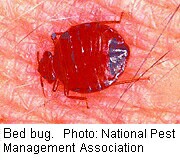
WEDNESDAY, April 10 (HealthDay News) — A centuries-old bedbug remedy has scientists full of beans — kidney beans to be precise.
The bean leaves used to trap bedbugs hundreds of years ago in southeastern Europe may offer a model for a non-toxic, modern-day treatment, say U.S. researchers.
The biting nocturnal insects have invaded U.S. homes, hotels, schools, hospitals and more in recent years, causing widespread itching, burning and psychological distress.
“Plants exhibit extraordinary abilities to entrap insects,” the study’s lead author, Catherine Loudon, an entomologist at the University of California, Irvine, said in a university news release. “Modern scientific techniques let us fabricate materials at a microscopic level, with the potential to ‘not let the bedbugs bite’ without pesticides.”
Microscopic hairs on kidney bean leaves stab the insects, effectively trapping them, the researchers discovered. They are using their findings to develop non-toxic synthetic materials that will mimic the effects of the bean leaves and help prevent bedbug infestations, according to the report, published online April 9 in the Journal of the Royal Society Interface.
Methods currently used to combat bedbug infestations include freezing, extreme heating, vacuuming and pesticides.
The age-old Balkan treatment involved scattering kidney bean leaves on the floor next to beds to ensnare the blood-thirsty critters.
Within seconds of stepping on a leaf, the bugs were trapped. Microscopic hooked hairs on the leaves, known as trichomes, stab the bugs’ legs and immobilize them, the researchers explained.
“Nature is a hard act to follow, but the benefits could be enormous,” study co-author Michael Potter, an entomologist at the University of Kentucky, Lexington, said in the news release. “Imagine if every bedbug inadvertently brought into a dwelling was captured before it had a chance to bite and multiply,” Potter said.
The researchers have modeled materials after the bean leaves in an attempt to reproduce their immobilizing effect. So far, synthetic surfaces have slowed the bugs down, but have yet to stop them in their tracks.
The study authors said more research is needed. They noted that bean leaves themselves are not a practical long-term solution because they dry out and don’t last long, but synthetic materials might provide a safe and effective alternative.
More information
The U.S. Centers for Disease Control and Prevention provides more information on bedbugs.

